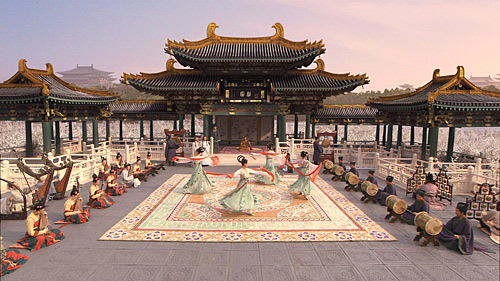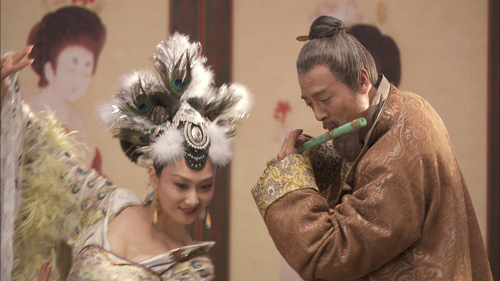|
 |
|
A scene from the documentary The Da Ming Palace (LIU YU) |
Lovely as peonies in full blossom, models of antique beauty in traditional Chinese costumes gracefully moved with light steps through the meeting hall of UN headquarters, immediately capturing the attention of the audience that had gathered for the premiere of an epic documentary film, The Da Ming Palace.
As the first Chinese movie to be screened at UN headquarters in New York, The Da Ming Palace tells the story of the imperial palace during the flourishing Tang Dynasty (618-907) more than 1,000 years ago.
During the premiere, Ambassador Liu Zhenmin, China's deputy permanent representative to the UN, said the Tang Dynasty enjoys a "significant and unique status in China's history." The Tang Dynasty had 20 emperors who ruled China from the 7th to 9th centuries "China at that time was a remarkably open society, with unprecedented frequent and extensive exchanges and interactions with the rest of the world," said Liu.
The Tang Dynasty, spanning almost 300 years, represents an apex in terms of economical and cultural development in ancient China. The era was marked by political stability, booming trade, thriving culture and religious growth.
As early as some 1,300 years ago, the Tang Dynasty's capital Chang'an--now known as Xi'an, capital of Shaanxi Province in northwest China--was home to a population of one million, making it the world's biggest city at the time. Chang'an was the starting point of the Silk Road, which continued to bring the city great wealth while turning it into a religious and cultural melting pot for more than 1,000 years. Archeological studies reveal that, since the Tang Dynasty had diplomatic ties with an estimated 300 foreign countries and states, envoys from neighboring Japan, Korea and India, as well as the remote Arab Empire and East Roman Empire, came to visit the capital city during that time.
Within the stupendous Chang'an walls, the town was divided into two parts by eight trunk streets. Surrounded by civilian residences, the inner part of the city was built around government buildings. The Da Ming Palace was constructed facing the south like most traditional Chinese architecture. The Tang people saw the blossoms of magnolia flowers as signs of purity, and thus planted them on the palace premises.
The palace covered a total area of 3.75 square km, 2.5 km from north to south and 1.5 km from east to west, with 11 gates. Through the front gate, the Danfeng Gate, people entered the main hall Hanyuan Hall. More than 30 other architectural elements including annex buildings, pavilions, gardens and temples dotted the palace grounds. "It was three times the size of the Palais of Versailles, four times larger than the Forbidden City, and 12 times larger than the Kremlin," said Zhou Bing, President of the Da Ming Palace Academy, which was established in October 2008.
 |
|
A scene from ducomentary The Da Ming Palace shows Emperor Xuanzong, Li Longji (right)and his favorite concubine Yang Guifei (LIU YU) |
Construction on the Da Ming Palace began in the year 634., the eighth year under the Zhenguan Reign of Emperor Taizong, the second emperor of the Tang Dynasty, and was completed under the reign of the following Emperor Gaozong.
It was said that when the laborers built the palace, they found an ancient bronze mirror deep underground. It was believed to be a quite powerful and magical mirror owned by Emperor Qin Shi Huang, the ruler who united China in 221 B.C. and commissioned the famous terracotta warriors. After the huge project was completed, the mirror was put inside the palace as a state treasure. Whether or not the mirror had powers, the Da Ming Palace witnessed the great era of an imperial dynasty, featuring a developed economy, blooming culture and state-of-the-art architectural techniques.
As the political and cultural center of the Tang Dynasty for almost 300 years, the palace was destroyed in a savage fire during heavy wars in the year 885, leaving the whole town in ruins. Although the architecture no longer exists, parts of Hanyuan Hall and Danfeng Gate, along with several other halls, have been preserved through history. They stand there silently, telling a glorious legend buried beneath the rubble.
Now a remarkable documentary is bringing that legend to life once again. The film is based on the collaborative work of Chinese and Japanese archaeologists who searched the ruins over the past 50 years for insights into imperial life, said director Jin Tiemu, who previously produced the widely acclaimed epic documentary Yuan Ming Yuan Imperial Garden in 2006. "Despite the special 3D-effects used to illustrate features of the palace, the story and the characters in the film are in complete accordance with historical information. None of it is fiction," said Jin, adding that the Tang culture is an absolute revelation to modern society. "I hope to present modern people with a true history to understand the spirit of Tang embedded within."
"Through the documentary, we will not only get a glimpse of what the Tang Dynasty was like and how prosperous, peaceful and harmonious China was at that time, but we will also see that a magnificent imperial palace once exclusively enjoyed by emperors has now been turned into a public park," said Ambassador Liu.
After the founding of the People's Republic of China, archeologists started to unearth the palace in 1957. In 1961, it was listed as a key preservation site by the International Council on Monuments and Sites. In 2008, the project of building a national heritage park project was initiated on the ruins of the Da Ming Palace; it was included as a major cultural relic preservation program in China's 11th Five-year Plan (2006-10) with a total investment of 12 billion yuan ($1.76 billion). The Da Ming Palace National Heritage Park, the size of Central Park in New York, is expected to open to the public on October 1, 2010, China's National Day.
(Reporting from New York) |
